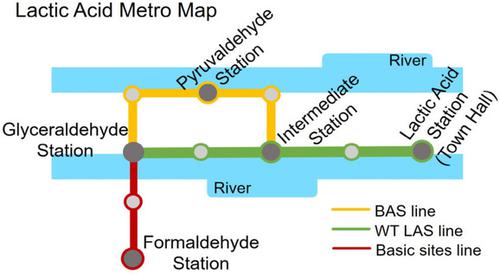当前位置:
X-MOL 学术
›
ChemCatChem
›
论文详情
Our official English website, www.x-mol.net, welcomes your feedback! (Note: you will need to create a separate account there.)
The Role of Brønsted and Water‐Tolerant Lewis Acid Sites in the Cascade Aqueous‐Phase Reaction of Triose to Lactic Acid
ChemCatChem ( IF 4.5 ) Pub Date : 2019-06-06 , DOI: 10.1002/cctc.201900519 Kryslaine M. A. Santos 1 , Elise M. Albuquerque 2 , Giada Innocenti 3, 4, 5 , Luiz E. P. Borges 1 , Carsten Sievers 3 , Marco A. Fraga 1, 2
ChemCatChem ( IF 4.5 ) Pub Date : 2019-06-06 , DOI: 10.1002/cctc.201900519 Kryslaine M. A. Santos 1 , Elise M. Albuquerque 2 , Giada Innocenti 3, 4, 5 , Luiz E. P. Borges 1 , Carsten Sievers 3 , Marco A. Fraga 1, 2
Affiliation

|
Aqueous‐phase conversion of glyceraldehyde to lactic acid was investigated over Nb2O5, TiO2, ZrO2 and SnO2 in a fixed‐bed up‐flow reactor. Special attention was given to the catalysts acidity regarding the type, amount, strength and tolerance to water of surface acid sites. These sites were assessed by infrared spectroscopy of pyridine adsorbed on dehydrated and hydrated catalysts as well as by isopropanol decomposition. It was found that Nb2O5 and TiO2 have the highest fraction of water‐tolerant Lewis acid sites (40 and 47 %), while only 6 % was estimated for ZrO2. No relevant Lewis acidity was observed on SnO2, but it was noticed the presence of strong base sites. The transformation of glyceraldehyde into lactic acid proceeded via a cascade reaction in which glyceraldehyde is firstly dehydrated to pyruvaldehyde, followed by its rearrangement to lactic acid with the addition of a water molecule. The dehydration step occurs on Brønsted acid sites and/or on water‐tolerant Lewis acid sites. These latter sites also determine the selectivity to lactic acid. Strong base sites promote glyceraldehyde fragmentation leading to formaldehyde with high selectivity.
中文翻译:

布朗斯台德和耐水路易斯酸位在三糖与乳酸的级联水相反应中的作用
在固定床上流反应器中,在Nb 2 O 5,TiO 2,ZrO 2和SnO 2上研究了甘油醛向乳酸的水相转化。在表面酸性部位的类型,数量,强度和对水的耐受性方面,对催化剂的酸度给予了特别关注。这些位点通过吸附在脱水和水合催化剂上的吡啶的红外光谱以及通过异丙醇分解来评估。结果发现,Nb 2 O 5和TiO 2的耐水路易斯酸位点比例最高(分别为40%和47%),而ZrO 2估计仅为6%。。在SnO 2上未观察到相关的路易斯酸度,但注意到存在强碱位。甘油醛向乳酸的转化通过级联反应进行,在该级联反应中,首先将甘油醛脱水为丙酮醛,然后通过添加水分子将其重新排列为乳酸。脱水步骤发生在布朗斯台德酸性位和/或耐水路易斯酸位上。这些后面的位点也决定了对乳酸的选择性。强碱位促进甘油醛断裂,从而高选择性地产生甲醛。
更新日期:2019-06-06
中文翻译:

布朗斯台德和耐水路易斯酸位在三糖与乳酸的级联水相反应中的作用
在固定床上流反应器中,在Nb 2 O 5,TiO 2,ZrO 2和SnO 2上研究了甘油醛向乳酸的水相转化。在表面酸性部位的类型,数量,强度和对水的耐受性方面,对催化剂的酸度给予了特别关注。这些位点通过吸附在脱水和水合催化剂上的吡啶的红外光谱以及通过异丙醇分解来评估。结果发现,Nb 2 O 5和TiO 2的耐水路易斯酸位点比例最高(分别为40%和47%),而ZrO 2估计仅为6%。。在SnO 2上未观察到相关的路易斯酸度,但注意到存在强碱位。甘油醛向乳酸的转化通过级联反应进行,在该级联反应中,首先将甘油醛脱水为丙酮醛,然后通过添加水分子将其重新排列为乳酸。脱水步骤发生在布朗斯台德酸性位和/或耐水路易斯酸位上。这些后面的位点也决定了对乳酸的选择性。强碱位促进甘油醛断裂,从而高选择性地产生甲醛。

































 京公网安备 11010802027423号
京公网安备 11010802027423号